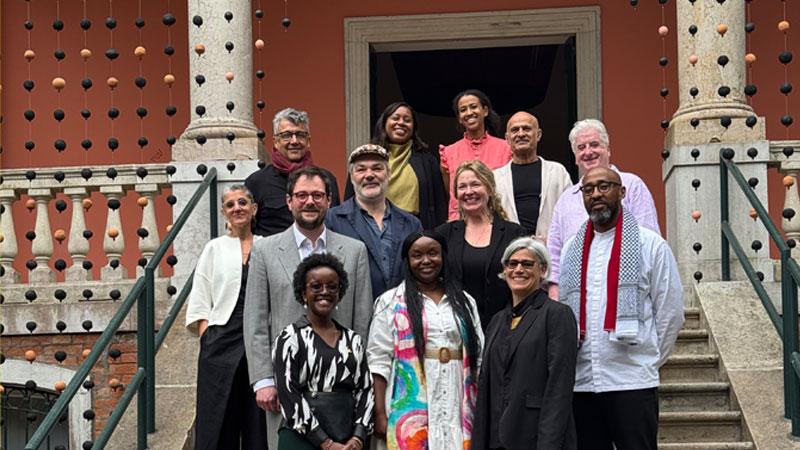Colleagues and alumni from Westminster’s School of Architecture + Cities (A+C) have exhibited a range of installations at the prestigious 19th Annual Venice Biennale of Architecture, with this year's theme using collective intelligence to address the climate crisis. This includes A+C projects displayed as part of the British Pavilion exhibition, co-curated by Westminster alumnus Kabage Karanja, which was given the Special Mention for Best National Participation.

From 10 May to 23 November 2025, the annual festival will showcase an array of installations organised around the themes of Natural, Artificial and Collective Intelligence to address real-world challenges related to climate change. This includes work displayed at the British Council’s annual British Pavilion exhibition, this year curated by a team including Westminster Architecture MArch (RIBA Part II) alumnus Kabage Karanja, Co-founder of Kenyan architectural practice Cave_bureau.
Kabage’s team were selected to curate the exhibition from a shortlist of four proposals judged by architects, educators and cultural professionals from across the UK and Kenya. The exhibition, titled Geology of Britannic Repair (GBR), explores architectures of repair, restitution and renewal and has been awarded the Special Mention for Best National Participation at the Biennale.
The work of Westminster Senior Lecturers Dr Yara Sharif and Dr Nasser Golzari, co-founders of Palestine Regeneration Team (PART) alongside Professor Murray Fraser from the University College London Bartlett School of Architecture, is currently exhibited as part of the GBR exhibition. Dr Sharif and Dr Golzari have recently co-founded Architects for Gaza, a group of architects committed to the restoration of lives, homes and neighbourhoods in Gaza.
In their contribution, titled Objects of Repair, PART explained that they “unpack the exploitative colonial practices that fracture the Palestinian landscape and showcase moments of hope and repair”. Central to the exhibition is an installation and film titled The Power of the Invisibles, led by Dr Sharif and Dr Golzari with Westminster Senior Lecturer Francois Girardin and the Architects for Gaza team.
This installation was designed specifically to narrate Gaza and radically rethinks the meaning of reconstruction. It proposes new spatial possibilities that transform ruins and salvaged materials into objects of healing and repair. Embracing impermanence as a tool of reclamation, the work draws inspiration from local innovation and available resources. This approach led to the development of an Atlas of Materials and a Matrix of Tools and Skills, offering alternative possibilities for building amidst scarcity.

Photo credit: Sara Daoudi
Dr Rosa Schiano-Phan, Reader in Architecture and Environmental Design at Westminster, and Dr Juan Vallejo, Visiting Lecturer in Architecture and Environmental Design, were also part of a team showing work at the Biennale. Their project, titled Urban Evaporative Cooling and the Ecological Semiotics of Heat and Pollution in Athens, explores the potential for zero energy, water-based downdraught evaporative installations as experimental urban natural cooling in the city of Athens, which is facing near-term existential environmental threats.

Rosa Schiano-Phan and team in front of their installation
About the festival Dr Sharif and Dr Golzari said: “We are proud to bring our work to an international platform like the Venice Architecture Biennale that has long shaped architectural discourse worldwide. Being part of this moment not only amplifies the voice of Gaza but also grows an international network of solidarity and support. Our message is clear: architecture bears an ethical responsibility to expose systemic injustice and to imagine alternative design practices that challenge the colonial extraction of land and resources.”
Kate Cheyne, Head of the Westminster School of Architecture + Cities, commented: “For Architecture + Cities at Westminster, having colleagues and alumni chosen to be included in such an internationally renowned Biennale highlights the excellence in our School. We are very proud that their work has been recognised here.”
The work displayed at the Venice Biennale directly contributes to several of the United Nations Sustainable Development Goals (SDGs) including 9: Industry, Innovation and Infrastructure, 13: Climate Action and 17: Partnerships for the Goals. Since 2019, the University of Westminster has used the SDGs holistically to frame strategic decisions to help students and colleagues fulfil their potential and contribute to a more sustainable, equitable and healthier society.
Find out more about Architecture, Interiors and Urban Design courses at the University of Westminster.






